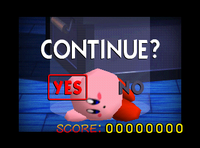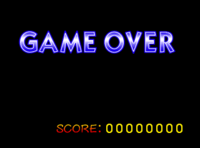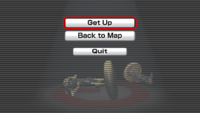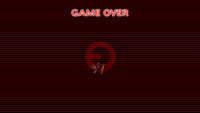Continue: Difference between revisions
Sportsfanrob (talk | contribs) |
(Undid edit by Sportsfanrob: broke image link) Tag: Undo |
||
| Line 58: | Line 58: | ||
Game Over.png|"Game Over" if No is selected, there are not enough or no coins, or if a player is defeated in Boss Battles Mode in Brawl. | Game Over.png|"Game Over" if No is selected, there are not enough or no coins, or if a player is defeated in Boss Battles Mode in Brawl. | ||
Continue Smash4.png|The continue screen as seen in SSB4. | Continue Smash4.png|The continue screen as seen in SSB4. | ||
Super Smash Bros. Ultimate Classic Mode continue screen.png|The continue screen as seen in Ultimate. | <!--Super Smash Bros. Ultimate Classic Mode continue screen.png|The continue screen as seen in Ultimate. | ||
</gallery> | </gallery> | ||
Revision as of 15:09, April 23, 2019
- "Game Over" redirects here. For the tournament, see Tournament:Game Over.
In all five games, when the player loses in a one player match such as 1P Game, Classic, Adventure, or All-Star Mode, they must trade coins in order to have an extra number of lives in stock. This is known as a Continue. Continues can occur in Classic Mode, Super Smash Bros.'s 1P Game, All-Star Mode (except in Super Smash Bros. for Nintendo 3DS and Super Smash Bros. for Wii U), Melee's Adventure Mode, Brawl's Subspace Emissary, and Ultimate's World of Light. Despite its similarity in format to All-Star Mode, Boss Battles Mode does not allow players to continue upon being KO'd.
In Classic, Adventure, and All-Star
When the player runs out of stocks, they are faced with a screen with the Announcer asking them whether they wish to continue or not. In the 1P Game of Super Smash Bros., the player can continue as many times as they wish. In Melee and Brawl, however, the player will not have a choice to continue and gain an extra number of lives if they do not have enough coins to pay; they are instead given a Game Over and have to start the mode over again. If they have sufficient funds, then the player can choose whether or not to continue. If the player chooses "No" and decides to exit, a Game Over still occurs. If they choose "Yes", however, then the game continues, with the player regaining all their lives and continuing the game as usual.
Continuing the game in these three games will cut the total score the player earned in half; however, they also gain one point for each continue. In addition, Melee and Brawl continues will cause the player to trade a fixed number of coins in order to continue. Higher difficulties mean higher loss of coins, except for Melee's All-Star Mode, in which continues always cost 10 coins on all difficulties.
In Melee, on both Classic Mode and Adventure Mode, the values are:
- Very Easy: 1 coin
- Easy: 2 coins
- Normal: 3 coins
- Hard: 5 coins
- Very Hard: 10 coins
All-Star Mode in Melee always costs 10 coins regardless of difficulty.
In Brawl, on both Classic Mode and All-Star Mode, these are the values:
- Easy: 10 coins
- Normal: 20 coins
- Hard: 30 coins
- Very Hard: 50 coins
- Intense: 100 coins
If the player cleared the game on any difficulty in Classic Mode, Adventure Mode, or All-Star Mode by using continues, the "Continuation" bonus in Melee or the "Used a Continue bonus" in Brawl is given, worth −20,000 points.
In Super Smash Bros. for Nintendo 3DS and Super Smash Bros. for Wii U, continuing is only possible in Classic Mode. Unlike in Melee and Brawl, the player does not use their funds to continue. Instead, it removes some rewards that the player has attained to that point and drops the intensity by 0.5, down to no lower than a minimum of 2.0. A "Game Over" is actually shown before choosing to continue in Super Smash Bros. for Nintendo 3DS.
In Super Smash Bros. Ultimate, the player can continue by spending Gold to lower the intensity or by using a Classic Ticket without lowering the intensity. Upon continuing, the match will start from where the player left off, unlike in other Super Smash Bros. games. The Third option is "Quit" and the player sees the final results earlier than completing the modes like in Smash 4.
Subspace Emissary
When the player runs out of stock in the Subspace Emissary, they are faced with a similar choice whether to continue or not. However, there are now three options; Get Up, Back to Map, and Quit. If the player chooses "Back to Map", then they exit the level and can choose another. If they chose "Quit", it's game over and they get to save and automatically return to the Solo menu. Both options cause the player to lose all stickers and trophies they had collected in the level. A Game Over screen appears for "Quit", but not "Back to Map". Unlike Classic and All-Star Mode, continuing in the Subspace Emissary does not cost coins, but it does carry other consequences.
If the player chooses "Get Up" in the Subspace Emissary, they can gain an extra set of lives in stock; and these events occur:
- The number of stickers and trophies, including those obtained by the Trophy Stand, attained in the stage is halved. Anything attained from Golden Boxes, however, cannot be lost.
- The player respawns at the last opened door or at the start of the level.
- The amount of coins for clearing that stage is reduced.
World of Light
If a player fails a match in World of Light, they will be given the chance to challenge the fight again by selecting Rematch. Their primary spirit will gain experience, like it does when a match is won, but in a noticeably smaller amount. The player can retry a match as many times as they want to, with no penalty.
Gallery
- MeleeContinue.jpg
The Continue screen in Melee.
Trivia
- Continuing results in the player's score being increased by one. This is used to show how many times the player has continued.
- Kid Icarus: Uprising, a game also directed by Masahiro Sakurai, also uses this system.









